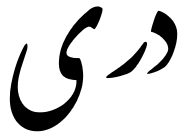Difference between revisions of "Language/Dari/Grammar/Describing-People-and-Things"
m (Quick edit) |
m (Quick edit) |
||
| Line 196: | Line 196: | ||
[[Category:Dari-0-to-A1-Course]] | [[Category:Dari-0-to-A1-Course]] | ||
<span gpt></span> <span model=gpt-3.5-turbo></span> <span temperature=1></span> | <span gpt></span> <span model=gpt-3.5-turbo></span> <span temperature=1></span> | ||
==Other Lessons== | |||
* [[Language/Dari/Grammar/0-to-A1-Course|0 to A1 Course]] | |||
* [[Language/Dari/Grammar/Adjectives|Adjectives]] | |||
* [[Language/Dari/Grammar/Personal-Pronouns|Personal Pronouns]] | |||
* [[Language/Dari/Grammar/Plurals|Plurals]] | |||
* [[Language/Dari/Grammar/Definite-and-Indefinite-Articles|Definite and Indefinite Articles]] | |||
* [[Language/Dari/Grammar/Questions|Questions]] | |||
* [[Language/Dari/Grammar/Basic-Verb-Conjugation|Basic Verb Conjugation]] | |||
* [[Language/Dari/Grammar/Past-Tense|Past Tense]] | |||
* [[Language/Dari/Grammar/Basic-Prepositions|Basic Prepositions]] | |||
{{Dari-Page-Bottom}} | {{Dari-Page-Bottom}} | ||
<span links></span> | <span links></span> | ||
Revision as of 21:37, 2 April 2023
Introduction
As a Dari language learner, you know that adjectives are essential to describe people, places, and things. In this lesson, we will go over the basics of adjectives in Dari and learn how to use them to describe the world around us. We will also cover adverbs, which modify verbs, adjectives, and other adverbs, and add more information to the sentence.
After mastering this lesson, these related pages might interest you: How to Use Be & Comparatives and Superlatives.
Adjectives
In Dari, adjectives usually come after the noun they modify, but some adjectives may come before the noun to emphasize a specific quality. Adjectives may also change depending on the gender and number of the noun they describe.
Position of Adjectives
In general, adjectives in Dari come after the noun they modify. For example:
| Dari | Pronunciation | English |
|---|---|---|
| سفید کتاب | safed ketāb | white book |
| بلند کوه | boland kuh | tall mountain |
| زیبا دختر | zibā dokhtar | beautiful girl |
As you can see from the examples above, the adjective is placed after the noun it modifies. However, some adjectives may come before the noun to emphasize a particular quality.
Gender and Number Agreement
In Dari, adjectives must agree in gender and number with the noun they describe. If the noun is masculine, the adjective takes the masculine form, and if the noun is feminine, the adjective takes the feminine form. If the noun is plural, the adjective must be pluralized as well.
| Dari | Pronunciation | English |
|---|---|---|
| کتاب خوب | ketāb-e khub | good book |
| دختر خوشگل | dokhtar-e khoshgel | pretty girl |
| مردان بلند قد | mardān-e boland qad | tall men |
| زنان خوشحال | zanān-e khoshhāl | happy women |
As you can see, the adjectives agree in gender and number with the respective nouns they describe.
Comparative and Superlative Adjectives
In Dari, comparative and superlative adjectives are formed by adding suffixes to the root adjective. Here are some examples:
| Dari | Pronunciation | English |
|---|---|---|
| کتاب خوب | ketāb-e khub | good book |
| کتاب بهتر | ketāb-e behtar | better book |
| کتاب خوبترین | ketāb-e khobtarin | best book |
| دختر خوشگل | dokhtar-e khoshgel | pretty girl |
| دختر زیباتر | dokhtar-e zibatar | prettier girl |
| دختر زیباترین | dokhtar-e zibatrin | prettiest girl |
As you can see, the suffix "-tar" is used to form the comparative form of the adjective and the suffix "-tarin" is used to form the superlative form of the adjective.
Adverbs
Adverbs modify verbs, adjectives, and other adverbs, and add more information to the sentence. In Dari, adverbs are usually formed by adding the suffix "-an" to the stem of the adjective. Here are some examples:
| Dari | Pronunciation | English |
|---|---|---|
| زیبا | zibā | beautiful |
| زیبان | zibān | beautifully |
| صبح | sobh | morning |
| صبحانه | sobhāneh | in the morning |
| خوب | khub | good |
| خوبان | khobān | well |
Practice
Now it's time to put your knowledge into practice! Here are some exercises to help you practice using adjectives and adverbs in Dari:
- Create five sentences that describe people, places, or things around you using adjectives.
- Create five sentences that describe actions using adverbs.
- Create five comparative or superlative sentences comparing people, places, or things.
Take your time and practice until you feel comfortable with the material. As always, it's essential to review previous lessons and practice consistently to improve your language skills.
Conclusion
In this lesson, we learned how to use adjectives and adverbs in Dari to describe people, places, and things. We also covered how adjectives and adverbs agree in gender and number with the nouns they modify and how to form comparative and superlative adjectives. Make sure to practice using adjectives and adverbs consistently, and don't be afraid to make mistakes. Keep up the good work, and see you in the next lesson!
Excellent job on conquering this lesson! Consider delving into these related pages: Gender & Noun Gender and Plurals.
Other Lessons
- 0 to A1 Course
- Adjectives
- Personal Pronouns
- Plurals
- Definite and Indefinite Articles
- Questions
- Basic Verb Conjugation
- Past Tense
- Basic Prepositions
